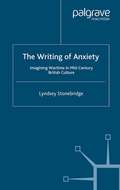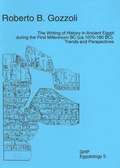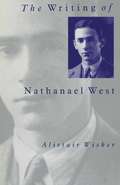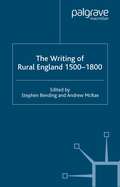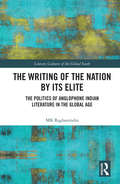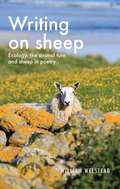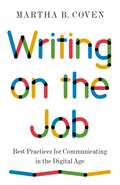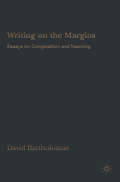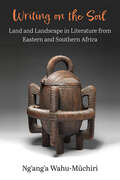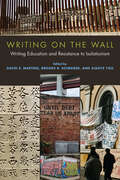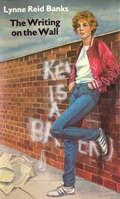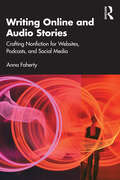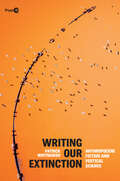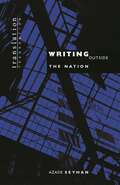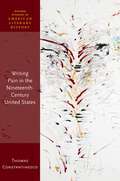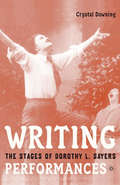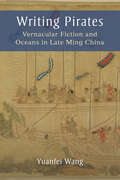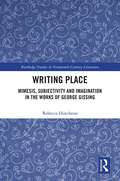- Table View
- List View
The Writing of Anxiety: Imagining Wartime in Mid-Century British Culture (Language, Discourse, Society)
by L. StonebridgeThis study suggests that it was the representation of anxiety, rather than trauma and memory, that emerged most forcefully in mid-century wartime culture. Thinking about anxiety, Lyndsey Stonebridge argues, was a way of imagining how it might be possible to stay within a history that frequently undermined a sense of self and agency.
Writing of History in Ancient Egypt During the First Millenium BC (ca. 1070-180 BC). Trend and Perspectives, The (PDF)
by Roberto O. Gozzoli Roberto B. GozzoliRoyal inscriptions, Herodotus and Manetho have been fundemental in order to reconstruct the chronology and history of ancient Egypt since Champillon's times. Without denying the righteousness of the approach, historical and pseudo-historical material are here analysed as historical documents per se, completely disregarding their value for the histoire evenementielle . Genre and format of royal inscriptions become important in order to establish the power of the tradition, as the entire group of historical sources mentioned embody hopes, fears, as well as social and cultural conflicts existing in Egyptian society at the times they were written.
The Writing of Rural England, 1500-1800
by S. Bending A. McRaeThe Writing of Rural England 1500-1800 documents and contextualizes the conflicting representations of rural life during a crucial period of social, economic and cultural change. It highlights the dialogues and tensions between agriculture and aesthetics, economics and morality, men and women, leisure and labour. By drawing on both canonical and marginal texts, it argues that early-modern writing not only reflected but played a part in constructing the cultural meanings of the English countryside with which we continue to live.
The Writing of the Nation by Its Elite: The Politics of Anglophone Indian Literature in the Global Age (Literary Cultures of the Global South)
by MK RaghavendraThis volume examines the idea of India as it emerges in the writing of its anglophone elite, post-2000. Drawing on a variety of genres, including fiction, histories, non-fiction assessments – economic, political, and business – travel accounts, and so on, this book maps the explosion of English-language writing in India after the economic liberalization and points to the nation’s sense of its growing importance as a producer of culture. From Ramachandra Guha to William Dalrymple, from Arundhati Roy to Pankaj Mishra, from Jhumpa Lahiri to Amitav Ghosh, from Amartya Sen to Gurcharan Das, from Barkha Dutt to Tarun Tejpal, this investigation takes us from aesthetic imaginings of the nation to its fractured political fault lines, the ideological predispositions of the writers often pointing to an asymmetrically constituted India. A major intervention on how postcolonial India is written about and imagined in the anglophone world, this book will be of great interest to scholars and researchers of cultural studies, literature, history, and South Asian studies. It will also be of interest to general readers with an inclination towards India and Indian writing.
The Writing of the Nation by Its Elite: The Politics of Anglophone Indian Literature in the Global Age (Literary Cultures of the Global South)
by MK RaghavendraThis volume examines the idea of India as it emerges in the writing of its anglophone elite, post-2000. Drawing on a variety of genres, including fiction, histories, non-fiction assessments – economic, political, and business – travel accounts, and so on, this book maps the explosion of English-language writing in India after the economic liberalization and points to the nation’s sense of its growing importance as a producer of culture. From Ramachandra Guha to William Dalrymple, from Arundhati Roy to Pankaj Mishra, from Jhumpa Lahiri to Amitav Ghosh, from Amartya Sen to Gurcharan Das, from Barkha Dutt to Tarun Tejpal, this investigation takes us from aesthetic imaginings of the nation to its fractured political fault lines, the ideological predispositions of the writers often pointing to an asymmetrically constituted India. A major intervention on how postcolonial India is written about and imagined in the anglophone world, this book will be of great interest to scholars and researchers of cultural studies, literature, history, and South Asian studies. It will also be of interest to general readers with an inclination towards India and Indian writing.
Writing on sheep: Ecology, the animal turn and sheep in poetry
by William WelsteadSheep are marginalised in literary criticism and in discussion of pastoral literature. This book brings an animal studies approach to poetry about sheep that allows for the agency of these sentient beings, that have been associated for humans over ten thousand years. This approach highlights the distinction between wild and domesticated species and the moral dilemma between the goals of animal welfare and those of saving species from extinction. Discussion of mostly contemporary poetry follows a new reading of works from the pastoral and georgic canon. Allowing for the sentience and sociality of this species makes it easier to imagine a natureculture within which to make kin across the species boundary. Reading poetry about sheep has the power to make new meanings as we try to adapt to an increasingly complex and problematic environment.
Writing on sheep: Ecology, the animal turn and sheep in poetry
by William WelsteadSheep are marginalised in literary criticism and in discussion of pastoral literature. This book brings an animal studies approach to poetry about sheep that allows for the agency of these sentient beings, that have been associated for humans over ten thousand years. This approach highlights the distinction between wild and domesticated species and the moral dilemma between the goals of animal welfare and those of saving species from extinction. Discussion of mostly contemporary poetry follows a new reading of works from the pastoral and georgic canon. Allowing for the sentience and sociality of this species makes it easier to imagine a natureculture within which to make kin across the species boundary. Reading poetry about sheep has the power to make new meanings as we try to adapt to an increasingly complex and problematic environment.
Writing on the Job: Best Practices for Communicating in the Digital Age
by Martha B. CovenA practical and compact guide to writing for professionalsWriting is an essential skill in today’s workplace. From messaging platforms and social media to traditional forms of communication like memos and reports, we rely on words more than ever. Given how much reading we do on mobile devices, being able to write succinctly is critical to success. Writing on the Job is an incisive guide to clear and effective writing for professionals.Martha Coven begins with the basics, explaining how to develop a professional style, get started on a piece of writing, create a first draft, and edit it into a strong final product. She then offers practical advice on more than a dozen forms of writing, from emails and slide decks to proposals and cover letters. Along the way, Coven provides a wealth of concrete examples and simple templates that make the concepts easy to understand and apply.Based on Coven’s popular writing classes and workshops at Princeton University as well as her decades of experience in the public and private sectors, Writing on the Job addresses the real challenges professionals face in today’s digital age, and shares essential practices that can improve the performance of any organization.
Writing on the Job: Best Practices for Communicating in the Digital Age
by Martha B. CovenA practical and compact guide to writing for professionalsWriting is an essential skill in today’s workplace. From messaging platforms and social media to traditional forms of communication like memos and reports, we rely on words more than ever. Given how much reading we do on mobile devices, being able to write succinctly is critical to success. Writing on the Job is an incisive guide to clear and effective writing for professionals.Martha Coven begins with the basics, explaining how to develop a professional style, get started on a piece of writing, create a first draft, and edit it into a strong final product. She then offers practical advice on more than a dozen forms of writing, from emails and slide decks to proposals and cover letters. Along the way, Coven provides a wealth of concrete examples and simple templates that make the concepts easy to understand and apply.Based on Coven’s popular writing classes and workshops at Princeton University as well as her decades of experience in the public and private sectors, Writing on the Job addresses the real challenges professionals face in today’s digital age, and shares essential practices that can improve the performance of any organization.
Writing on the Margins: Essays on Composition and Teaching
by D. BartholomaeA collection of twenty-one essays by David Bartholomae, Writing on the Margins includes selections that have helped shape the discipline of composition studies. With a wide-ranging introduction and three retrospective postscripts to set the essays in context, it serves as a valuable reference and as a powerful introduction to crucial issues in the field. This book has been awarded the MLA's Mina P. Shaugnessy Award, recognizing an outstanding research publication on the teaching of English.
Writing on the Soil: Land and Landscape in Literature from Eastern and Southern Africa (African Perspectives)
by Ng'ang'a Wahu-MuchiriAcross contiguous nation-states in Eastern Africa, the geographic proximity disguises an ideological complexity. Land has meant something fundamental in the sociocultural history of each country. Those concerns, however, have manifested into varied political events, and the range of struggles over land has spawned a multiplicity of literary interventions. While Kenya and Uganda were both British colonies, Kenya's experience of settler land alienation made for a much more violent response against efforts at political independence. Uganda's relatively calm unyoking from the colonial burden, however, led to a tumultuous post-independence. Tanzania, too, like Kenya and Uganda, resisted British colonial administration—after Germany's defeat in World War 1. In Writing on the Soil, author Ng’ang’a Wahu-Mũchiri argues that representations of land and landscape perform significant metaphorical labor in African literatures, and this argument evolves across several geographical spaces. Each chapter's analysis is grounded in a particular locale: western Kenya, colonial Tanganyika, post-independence Tanzania, Zimbabwe, Nairobi, Dar es Salaam, Anam Ka'alakol (Lake Turkana), Kampala, and Kitgum in Northern Uganda. Moreover, each section contributes to a deeper understanding of the aesthetic choices that authors make when deploying tropes revolving around land, landscape, and the environment. Mũchiri disentangles the numerous connections between geography and geopolitical space on the one hand, and ideology and cultural analysis on the other. This book embodies a multi-layered argument in the sphere of African critical scholarship, while adding to the growing field of African land rights scholarship—an approach that foregrounds the close reading of Africa’s literary canon.
Writing on the Wall: Writing Education and Resistance to Isolationism
by Xiaoye You David S. Martins Brooke R. SchreiberThe first concerted effort of writing studies scholars to interrogate isolationism in the United States, Writing on the Wall reveals how writing teachers—often working directly with students who are immigrants, undocumented, first-generation, international, and students of color—embody ideas that counter isolationism. The collection extends existing scholarship and research about the ways racist and colonial rhetorics impact writing education; the impact of translingual, transnational, and cosmopolitan ideologies on student learning and student writing; and the role international educational partnerships play in pushing back against isolationist ideologies. Established and early-career scholars who work in a broad range of institutional contexts highlight the historical connections among monolingualism, racism, and white nationalism and introduce community- and classroom-based practices that writing teachers use to resist isolationist beliefs and tendencies. “Writing on the wall” serves as a metaphor for the creative, direct action writing education can provide and invokes border spaces as sites of identity expression, belonging, and resistance. The book connects transnational writing education with the fight for racial justice in the US and around the world and will be of significance to secondary and postsecondary writing teachers and graduate students in English, linguistics, composition, and literacy studies. Contributors: Olga Aksakalova, Sara P. Alvarez, Brody Bluemel, Tuli Chatterji, Keith Gilyard, Joleen Hanson, Florianne Jimenez Perzan, Rebecca Lorimer Leonard, Layli Maria Miron, Tony D. Scott, Kate Vieira, Amy J. Wan
Writing On The Wall (A\charlotte Zolotow Bk.)
by Lynne Reid BanksTracy wasn't surprised that her dad disapproved of Kev, with his hair in spikes, his Dayglo socks and all the rest of his punk gear. But she liked the way he looked and enjoyed going round with him. Besides, she was determined to have a good time before she had to get some boring job and settle down, like her sister Mary.That was why the trip to Holland seemed such a great idea. Of course it was Kev who suggested it, and Tracy knew that her parents would never let her go off with Kev, just the two of them. On the other hand, if there was a whole bunch of them going, including her friend Karen and some of the others from school, Dad might - just might - say yes.As things turned out, persuading Dad to say yes was only the beginning of her troubles. In fact so much went wrong that it was hard, afterwards, to remember the good bits, and it wasn't until the whole awful business was over that Tracy realised she should have seen what was going on all along.
Writing Online and Audio Stories: Crafting Nonfiction for Websites, Podcasts, and Social Media
by Anna FahertyGuiding readers through the unique challenges and choices presented by digital publication, this book provides a practical set of tools to help students, creatives, and content professionals craft emotionally engaging nonfiction stories for online readers and listeners. From considering what story to tell, to bringing narratives to life in practice, Anna Faherty explains what gives stories their unique power and demonstrates how to successfully combine techniques from short-stories and screenwriting with journalistic practices like fact checking and verification. Examples from corporate websites, personal blogs, podcasts, and social media set out how to attract and involve readers and listeners, and how to prompt them to take action. Readers will come away with a straightforward framework for planning and crafting storytelling projects and an understanding of text and script development, copyright, and editing. Each chapter includes summaries of key principles and practical writing tips, while case studies share insights from writers’ professional practices – including those who use storytelling to influence customers or advocate for change. Writing Online and Audio Stories is a valuable entry-point for creative writers, podcasters, and professionals in PR and marketing, as well as students undertaking courses such as Digital Writing, Creative Nonfiction and Multimedia Storytelling.
Writing Online and Audio Stories: Crafting Nonfiction for Websites, Podcasts, and Social Media
by Anna FahertyGuiding readers through the unique challenges and choices presented by digital publication, this book provides a practical set of tools to help students, creatives, and content professionals craft emotionally engaging nonfiction stories for online readers and listeners. From considering what story to tell, to bringing narratives to life in practice, Anna Faherty explains what gives stories their unique power and demonstrates how to successfully combine techniques from short-stories and screenwriting with journalistic practices like fact checking and verification. Examples from corporate websites, personal blogs, podcasts, and social media set out how to attract and involve readers and listeners, and how to prompt them to take action. Readers will come away with a straightforward framework for planning and crafting storytelling projects and an understanding of text and script development, copyright, and editing. Each chapter includes summaries of key principles and practical writing tips, while case studies share insights from writers’ professional practices – including those who use storytelling to influence customers or advocate for change. Writing Online and Audio Stories is a valuable entry-point for creative writers, podcasters, and professionals in PR and marketing, as well as students undertaking courses such as Digital Writing, Creative Nonfiction and Multimedia Storytelling.
Writing Our Extinction: Anthropocene Fiction and Vertical Science (Post*45)
by Patrick WhitmarshMid-twentieth-century developments in science and technology produced new understandings and images of the planet that circulated the globe, giving rise to a modern ecological consciousness; but they also contributed to accelerating crises in the global environment, including climate change, pollution, and waste. In this new work, Patrick Whitmarsh analyzes postwar narrative fictions that describe, depict, or express the earth from above (the aerial) and below (the subterranean), revealing the ways that literature has engaged this history of vertical science and linked it to increasing environmental precarity, up to and including the extinction of humankind. Whitmarsh examines works by writers such as Don DeLillo, Karen Tei Yamashita, Reza Negarestani, and Colson Whitehead alongside postwar scientific programs including the Space Race, atmospheric and underground nuclear testing, and geological expeditions such as Project Mohole (which attempted to drill to the earth's mantle). As Whitmarsh argues, by focusing readers' attention on the fragility of postwar life through a vertical lens, Anthropocene fiction highlights the interconnections between human behavior and planetary change. These fictions situate industrial history within the much longer narrative of geological time and reframe scientific progress as a story through which humankind writes itself out of existence.
Writing Our Extinction: Anthropocene Fiction and Vertical Science (Post*45)
by Patrick WhitmarshMid-twentieth-century developments in science and technology produced new understandings and images of the planet that circulated the globe, giving rise to a modern ecological consciousness; but they also contributed to accelerating crises in the global environment, including climate change, pollution, and waste. In this new work, Patrick Whitmarsh analyzes postwar narrative fictions that describe, depict, or express the earth from above (the aerial) and below (the subterranean), revealing the ways that literature has engaged this history of vertical science and linked it to increasing environmental precarity, up to and including the extinction of humankind. Whitmarsh examines works by writers such as Don DeLillo, Karen Tei Yamashita, Reza Negarestani, and Colson Whitehead alongside postwar scientific programs including the Space Race, atmospheric and underground nuclear testing, and geological expeditions such as Project Mohole (which attempted to drill to the earth's mantle). As Whitmarsh argues, by focusing readers' attention on the fragility of postwar life through a vertical lens, Anthropocene fiction highlights the interconnections between human behavior and planetary change. These fictions situate industrial history within the much longer narrative of geological time and reframe scientific progress as a story through which humankind writes itself out of existence.
Writing Outside the Nation
by Azade SeyhanSome of the most innovative writers of contemporary literature are writing in diaspora in their second or third language. Here Azade Seyhan describes the domain of transnational poetics they inhabit. She begins by examining the works of selected bilingual and bicultural writers of the United States (including Oscar Hijuelos, Maxine Hong Kingston, and Eva Hoffman) and Germany (Libuse Moníková, Rafik Schami, and E. S. Özdamar, among others), developing a new framework for understanding the relationship between displacement, memory, and language. Considering themes of loss, witness, translation, identity, and exclusion, Seyhan interprets diasporic literatures as condensed archives of cultural and linguistic memory that give integrity and coherence to pasts ruptured by migration. The book next compares works by contemporary Chicana and Turkish-German women writers as innovative and sovereign literary voices within the larger national cultures of the United States and Germany. Seyhan identifies in American multiculturalism critical clues for analyzing new cultural formations in Europe and maintains that Germany's cultural transformation suggests new ways of reading the American literary mosaic. Her approach, however, extends well beyond these two literatures. She creates a critical map of a "third geography," where a transnational, multilingual literary movement is gathering momentum. Writing Outside the Nation both contributes to and departs from postcolonial studies in that it focuses specifically on transnational writers working outside of their "mother tongue" and compares American and German diasporic literatures within a sophisticated conceptual framework. It illustrates how literature's symbolic economy can reclaim lost personal and national histories, as well as connect disparate and distant cultural traditions.
Writing Outside the Nation (Translation/Transnation #31)
by Azade SeyhanSome of the most innovative writers of contemporary literature are writing in diaspora in their second or third language. Here Azade Seyhan describes the domain of transnational poetics they inhabit. She begins by examining the works of selected bilingual and bicultural writers of the United States (including Oscar Hijuelos, Maxine Hong Kingston, and Eva Hoffman) and Germany (Libuse Moníková, Rafik Schami, and E. S. Özdamar, among others), developing a new framework for understanding the relationship between displacement, memory, and language. Considering themes of loss, witness, translation, identity, and exclusion, Seyhan interprets diasporic literatures as condensed archives of cultural and linguistic memory that give integrity and coherence to pasts ruptured by migration. The book next compares works by contemporary Chicana and Turkish-German women writers as innovative and sovereign literary voices within the larger national cultures of the United States and Germany. Seyhan identifies in American multiculturalism critical clues for analyzing new cultural formations in Europe and maintains that Germany's cultural transformation suggests new ways of reading the American literary mosaic. Her approach, however, extends well beyond these two literatures. She creates a critical map of a "third geography," where a transnational, multilingual literary movement is gathering momentum. Writing Outside the Nation both contributes to and departs from postcolonial studies in that it focuses specifically on transnational writers working outside of their "mother tongue" and compares American and German diasporic literatures within a sophisticated conceptual framework. It illustrates how literature's symbolic economy can reclaim lost personal and national histories, as well as connect disparate and distant cultural traditions.
Writing Pain in the Nineteenth-Century United States (Oxford Studies in American Literary History)
by Thomas ConstantinescoWriting Pain in the Nineteenth-Century United States examines how pain is represented in a range of literary texts and genres from the nineteenth-century US. It considers the aesthetic, philosophical, and ethical implications of pain across the works of Ralph Waldo Emerson, Harriet Jacobs, Emily Dickinson, Henry James, Elizabeth Stuart Phelps, and Alice James, as the national culture of pain progressively transformed in the wake of the invention of anesthesia. Through examining the work of nineteenth-century writers, Constantinesco argues that pain, while undeniably destructive, also generates language and identities, and demonstrates how literature participates in theorizing the problems of mind and body that undergird the deep chasms of selfhood, sociality, gender, and race of a formative period in American history. Writing Pain in the Nineteenth-Century United States considers first Emerson's philosophy of compensation, which promises to convert pain into gain. It also explores the limitations of this model, showing how Jacobs contests the division of body and mind that underwrites it and how Dickinson challenges its alleged universalism by foregrounding the unshareability of pain as a paradoxical measure of togetherness. It then investigates the concurrent economies of affects in which pain was implicated during and after the Civil War and argues, through the example of James and Phelps, for queer sociality as a response to the heteronormative violence of sentimentalism. The last chapter on Alice James extends the critique of sentimental sympathy while returning to the book's premise that pain is generative and the site of thought. By linking literary formalism with individual and social formation, Writing Pain in the Nineteenth-Century United States eventually claims close reading as a method to recover the theoretical work of literature.
Writing Pain in the Nineteenth-Century United States (Oxford Studies in American Literary History)
by Thomas ConstantinescoWriting Pain in the Nineteenth-Century United States examines how pain is represented in a range of literary texts and genres from the nineteenth-century US. It considers the aesthetic, philosophical, and ethical implications of pain across the works of Ralph Waldo Emerson, Harriet Jacobs, Emily Dickinson, Henry James, Elizabeth Stuart Phelps, and Alice James, as the national culture of pain progressively transformed in the wake of the invention of anesthesia. Through examining the work of nineteenth-century writers, Constantinesco argues that pain, while undeniably destructive, also generates language and identities, and demonstrates how literature participates in theorizing the problems of mind and body that undergird the deep chasms of selfhood, sociality, gender, and race of a formative period in American history. Writing Pain in the Nineteenth-Century United States considers first Emerson's philosophy of compensation, which promises to convert pain into gain. It also explores the limitations of this model, showing how Jacobs contests the division of body and mind that underwrites it and how Dickinson challenges its alleged universalism by foregrounding the unshareability of pain as a paradoxical measure of togetherness. It then investigates the concurrent economies of affects in which pain was implicated during and after the Civil War and argues, through the example of James and Phelps, for queer sociality as a response to the heteronormative violence of sentimentalism. The last chapter on Alice James extends the critique of sentimental sympathy while returning to the book's premise that pain is generative and the site of thought. By linking literary formalism with individual and social formation, Writing Pain in the Nineteenth-Century United States eventually claims close reading as a method to recover the theoretical work of literature.
Writing Performances: The Stages of Dorothy L. Sayers
by C. DowningAfter Dorothy L. Sayers became famous for her fictional sleuth, Lord Peter Wimsey, she began investigating the mysteries of Anglo-Catholic Christianity, writing plays for both stage and radio. However, because her modernist contemporaries disdained both best-sellers and religious fiction, Sayers has been largely overlooked by the academy. Writing Performances is the first work to position Sayers' diverse writings within the critical climate of high modernism. Employing exuberant illustrations from Sayers' detective fiction to make theoretical issues accessible, the book employs insights from performance theory to argue that Sayers, though a popularizer, presciently anticipated the postmodern ironizing of Enlightenment rationality and scientific objectivity.
Writing Pirates: Vernacular Fiction and Oceans in Late Ming China
by Yuanfei WangIn Writing Pirates, Yuanfei Wang connects Chinese literary production to emerging discourses of pirates and the sea. In the late Ming dynasty, so-called “Japanese pirates” raided southeast coastal China. Hideyoshi invaded Korea. Europeans sailed for overseas territories, and Chinese maritime merchants and emigrants founded diaspora communities in Southeast Asia. Travel writings, histories, and fiction of the period jointly narrate pirates and China’s Orient in maritime Asia. Wang shows that the late Ming discourses of pirates and the sea were fluid, ambivalent, and dialogical; they simultaneously entailed imperialistic and personal narratives of the “other”: foreigners, renegades, migrants, and marginalized authors. At the center of the discourses, early modern concepts of empire, race, and authenticity were intensively negotiated. Connecting late Ming literature to the global maritime world, Writing Pirates expands current discussions of Chinese diaspora and debates on Sinophone language and identity.
Writing Place: Mimesis, Subjectivity and Imagination in the Works of George Gissing (Routledge Studies in Nineteenth Century Literature)
by Rebecca HutcheonExploring a hitherto neglected field, Writing Place: Mimesis, Subjectivity and Imagination in the Works of George Gissing is the first monograph to consider the works of George Gissing (1857-1903) in light of the ‘spatial turn’. By exploring how objectivity and subjectivity interact in his work, the book asks: what are the risks of looking for the ‘real’ in Gissing’s places? How does the inherent heterogeneity of Gissing’s observation influence the textual recapitulation of place? In addition to examining canonical texts such as The Nether World (1889), New Grub Street (1891), and The Private Papers of Henry Ryecroft (1901), the book analyses the lesser-known novels, short stories, journalism and personal writings of Gissing, in the context of modern spatial studies. The book challenges previously biographical and London-centric accounts of Gissing’s representation of space and place by re-examining seemingly innate contemporaneous geographical demarcations such as the north and the south, the city, suburb, and country, Europe and the world, and re-reading Gissing’s places in the contexts of industrialism, ruralism, the city in literature, and travel writing. Through sustained attention to the ambiguities and contradictions rooted in the form and content of his writing, the book concludes that, ultimately, Gissing’s novels undermine spatial dichotomies by emphasising and celebrating the incongruity of seeming certainties
